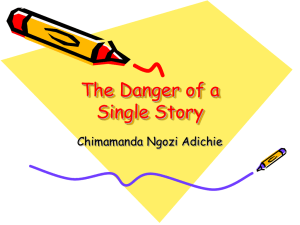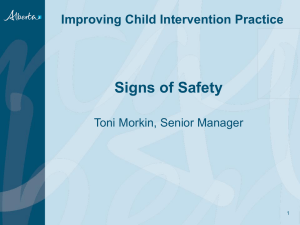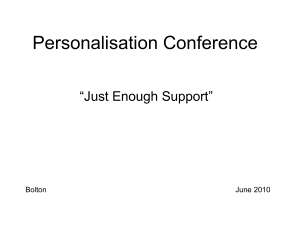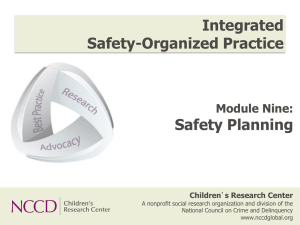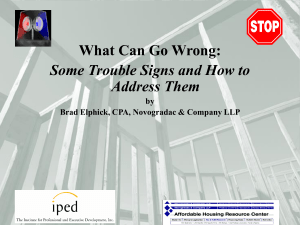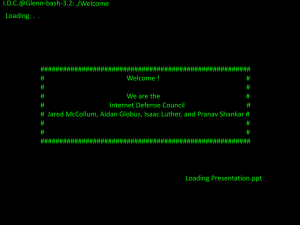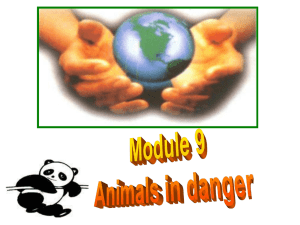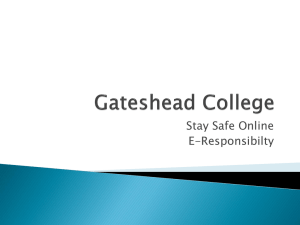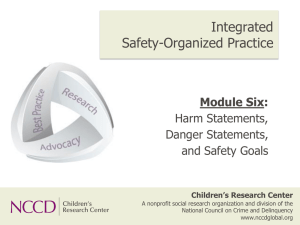SOP_CA_Three_Day_2013_Day_1
advertisement
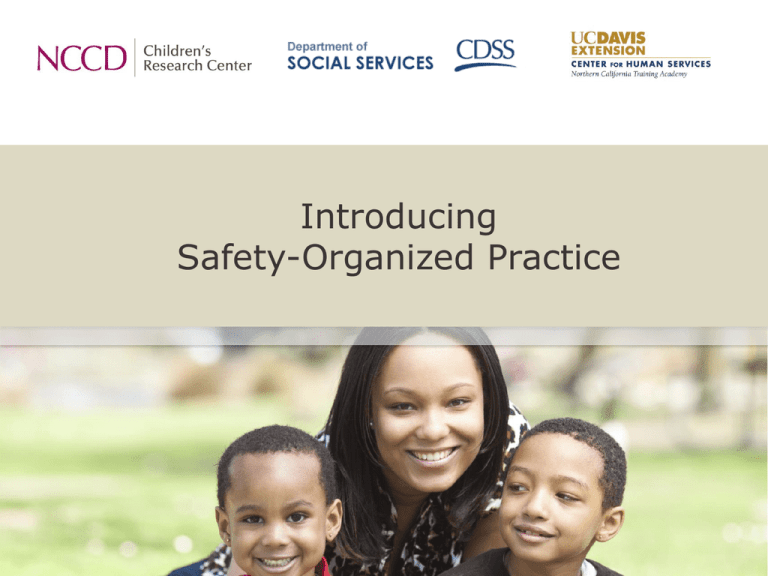
Introducing Safety-Organized Practice What Is Safety-Organized Practice? Cultural Humility Partnership-Based Collaborative Practice Signs of Safety Trauma-Informed Practice Multicultural Process of Change Appreciative Inquiry Solution-Focused Interviewing Signs of Safety • Developed in Australia in late 1990's by Steve Edwards and Andrew Turnell – bringing the best of solution focused therapy to CW • A response to both the need for critical thinking and enhanced partnerships • Objectives of Signs of Safety are: » ENGAGEMENT: Create a shared focus to guide casework among all stakeholders (child, family, worker, supervisor, etc.) » CRITICAL THINKING: Help these stakeholders consider complicated and ambiguous case information together and sort it into meaningful CW categories » ENHANCING SAFETY: Clear the way for stakeholders to engage in "rigorous, sustainable, on the ground child safety" efforts Trauma-Informed Practices Most of the children and many of the parents involved in the child welfare system have experienced some form of trauma. Symptoms of trauma can worsen already challenging situations and make the work of engagement and increasing child safety even more difficult. Trauma-informed practices can reduce ongoing symptoms and are woven into safety-organized practice. Safety-organized practice draws heavily from the National Child Traumatic Stress Network's principles and strategies and from Bruce Perry's work at the National Trauma Academy, which focuses on trauma's impact on brain development and child development. By focusing on assisting families and their communities in building their own capacities for keeping children safe, safety-organized practice helps clients respond to traumatic experiences. Cultural Humility Hu-mil-i-ty, noun. 1. The quality or condition of being humble; lack of pride; modesty. 2. The act of modesty or self-abasement; submission. The American Heritage Dictionary of the English Language (1973; p. 441) Cultural Humility A cultural humility perspective challenges us to learn from the people with whom we interact, reserve judgment, and bridge the cultural divide between our perspectives in order to facilitate well-being and promote improved quality of life. Such a perspective frees the observer from having to possess expert knowledge in order to maintain knowledge-based power, control, and authority over matters about which diverse populations are far more knowledgeable. Tervalon, M., and Murray-Garcia, J. (1998) Integrated Practice Contributions Steve de Shazer Insoo Kim Berg Sue Lohrbach Rob Sawyer Valarie Batts CRC Staff Child welfare professionals, families, and children across California Andrew Turnell Susie Essex Nicki Weld Sonja Parker Safety-Organized Practice GOOD WORKING RELATIONSHIPS • Solution-focused interviewing • Strategies for interviewing children CRITICAL THINKING • Mapping • Structured Decision Making® (SDM) assessments ENHANCING SAFETY • Harm and danger statements • Well-formed goals • Building safety networks • Collaborative planning What changes? What stays the same? The heart of the this approach is a focus on collaboratively created goals that describe what the statutory agency needs to see to close the case AND the family's ideas and ways of creating safety. Sometimes, the agency will be unable to fully support the family's specific perspectives and wishes. When indicators of harm and danger outweigh signs of safety, statutory intervention may be required, and this will always be part of the child protection role. Plan for the Day Morning •Background •Overview of these two days •Introductions •Community agreements Break •A rigorous, balanced assessment •Solution-focused interviewing Afternoon •A common language? •Mapping and mapping practice Overview of the Training Day Main Topics Wednesday Orientation, (re-)introducing safety-organized practice, interviewing for danger and safety, mapping Thursday Harm and danger statements, safety goals, networks, planning, interviewing children, next steps Introductions and Agreements Your Purpose for Being Here Imagine in two days you leave this training feeling as though it was really valuable for you to be here… What is the most that could happen in these two days that would leave you feeling it was worth the time to be here? On what, for you, does it depend? •What would the trainer(s) have to do? •What would your fellow workshop participants have to do? •What would you have to do (or not do)? The Approach to Teaching and Learning at This Workshop Teachers are facilitator-learners. Learners are holders of wisdom, knowledge, and skills. Workshop is a site where teacher and learner share knowledge and together develop something unique and new (e.g., 1 + 1 = 3). Learning from the inside out is being part of experiences, then stepping back from them to develop new learning and best practices. Emergent Design Proposed Community Agreements • "Try on" • We will respect all requests for confidentiality/anonymity. • Everyone always has the right to pass. • Silence is a contribution. • We agree to share airtime and stick to time limits. • We agree to speak personally, for ourselves as individuals. • We agree to be aware of the differences between intent and impact. • We agree to disagree and avoid making assumptions/generalizations. • We agree to allow others to finish speaking before we speak to avoid interruptions and side conversations. • We will work together to hold to these agreements and authorize the trainers to hold us to them. Interviewing for Safety and Danger Interviewing for Safety and Danger A practice of using questions and having conversations that gather rich, detailed, pertinent information about the history of protection and the history of the problem: • Helps key stakeholders (family, workers, providers, supervisors) think through difficult situations together; • Develops a common language, purpose, and goals; • Believes in the possibility of change; • Gathers the information needed for the CAT assessments and decision support; and • Is based on solution-focused interviewing. Click to edit Master title style What is the impact of the caregiver's actions on the child? Interviewing for Safety and Danger Her father: physically abusive, dangerous Foster care Past D V D E P R E S S I O N O F F M E D S Suicide attempt by gas in the kitchen while the children were home Poverty Present Future Interviewing for Safety and Danger ???? Past Present Future What will Cheryl's future probably look like? What do we know about danger? What do we know about safety? Interviewing for Safety and Danger Suicide attempt by gas in the kitchen while the children were home Past Present "I took the girls and put them in the next room." Future Interviewing for Safety and Danger Present Past "My mom gave custody of me to my aunt." "My mom and aunt made sure I got an education." L E F T H U S B Proper care of girls through school, doctor, therapy "I took the girls and put them in the next room." Future "I'm getting up at 4:00 a.m. to meet them and get them to school." Interviewing for Safety and Danger What will Cheryl's future probably look like? What do we know about danger? What do we know about safety? Past Present Future ???? "Naïve" Practice Past Present Future "Problem-Saturated" Practice Past Present Future "Naïve" Practice Past Present Future A Full Assessment Past Present Future The Three Questions Three Questions That Organize the Interview What are we worried about? What is working well? What needs to happen next? "What are we worried about?" Ask questions that… •Raise behavioral descriptions and move past vagueness, generalizations, and jargon; •Reveal all the family members' positions on the problem— especially the children's; •Stay connected to the focus of the interview: What is the impact of the caregiver's actions on the child?; and •Stay connected to the content you need to acquire: What CAT® questions will you need to answer to get the best possible help from the assessments? "What are we worried about?" Ask questions that reveal … Caregiver Behavior Impact on the child Exercise I: Surfacing the Generalizations We Live by Every Day! In Small Groups: Make an exhaustive list of ALL the generalizations, labels and generally IMPRECISE descriptions we use every day to describe families! •Start by taking a piece of paper and dividing it into half – the “working well” and the “worries”. •Then come up with a list of all the common phrases, descriptions, we use every day about families that tell us NOTHING about impact! •Take 5-10 minutes to do this. Prepare to report out to large group. •Keep it real! www.nccd-crc.org Generalizations Versus Behavioral Descriptions and Impact "She is mentally ill." • How does he/she know? • What caregiver behaviors are associated with it? • When do those behaviors show themselves? • How do those behaviors impact the child? • How do you know? How do you find out? » What does the child know? » What has the child seen? » What are you worried is happening or will happen? Generalizations Versus Behavioral Descriptions and Impact "He is an alcoholic." • What does he drink? • When does he drink? • Where is the child when he drinks? • What caregiver behaviors are associated with it? • When do those behaviors show themselves? • How do those behaviors impact the child? • How do you know? • How do you find out? Generalizations vs. Behavioral Descriptions and Impact Think to yourself the image of an “alcoholic”….hold that….would we all have the same interpretation? Even alcoholics say for years…”I’m an alcoholic”. Exercise Part II: Interviewing for ‘the Worries’ Get into Groups of Three: •Interviewer •Interviewee •Coach/observer The interviewer should ask questions of interviewee about a family they or a supervisee are working with, with the goal of reaching an exhaustive list of all the worries…but they need to be described in the following format: Caregiver Behavior Impact on the child Try not to use any of the vague or imprecise terms you just came up with! www.nccd-crc.org "What is working well?" There is always a history of protection. •Based in solution-focused questions. •If we do not know "what is working well," we do not know how worried to be. •Ask questions that rigorously surface the history of protection and how that history can be applied in the future for the child's safety. •"Listen for the empty spaces." Listening for the Empty Spaces Her father: physically abusive, dangerous Foster care Past D V D E P R E S S I O N O F F M E D S Suicide attempt by gas in the kitchen while the children were home Poverty Present Future Listening for the Empty Spaces Her father: physically abusive, dangerous Foster care Past D V D E P R E S S I O N O F F M E D S Suicide attempt by gas in the kitchen while the children were home Poverty Present Future What is the history of protection? "What is working well?" Ask questions that reveal … Caregiver Behavior Impact on the child Generalizations Versus Behavioral Descriptions and Impact "She is stable." • Stable meaning what? • Stable from what? • What caregiver behaviors are associated with stability? • When do those behaviors show themselves? • How do those behaviors impact the child? • How do you know? • How do you find out? Exercise: Two Reports Solution-Focused Interviewing Why Solution-Focused Interviewing? From multiple research studies: The best outcomes for children and families occur when constructive working relationships exist between families and professionals and between professionals themselves. Good working relationships are the best predictor of good outcomes! Solution-Focused Interviewing: At the Heart "Motivation (for change) may be linked to the degree of hope that change is possible." US National Clearinghouse on Child Abuse and Neglect Five Solution-Focused Questions Exception Questions • Past history of protection Scaling • Danger/safety • Progress Position Questions • Seeing through other people's eyes Coping Preferred Future • Skill at finding solutions to difficulty • Future goals All surrounded by: Cultural Humility Cultural Humility Scaling Exception Questions • Danger/safety • Progress • Past history of protection Coping • Skill at finding solutions to difficulty Position Questions • Seeing through other people's eyes Preferred Future • Future goals Cultural Humility Exception Questions "Has there ever been a time [the problem] could have happened…maybe almost did…but somehow you were able to do something different?" •Cornerstone of solution-focused question. •CRITICAL to get details. •Seeks times when the problem could have occurred as usual, but did not. •No problem is absolute in its effects. •A place to begin looking for safety, strengths, resources, and alternative actions. •People who know they have been able to change are more likely to do it again. Scaling Questions (Conversations) 0 Least 10 Most "On a scale from 0 to 10, with 0 being the most danger and 10 being the most safety for this child, where do you think this particular situation rates?" Follow-Up Questions • What exactly did you see or hear that allowed you to give the the rating you did and not one above or below? • What do you think would need to happen to increase your rating by one? • Can I tell you what my number is? This is what I think would need to happen for my number would go up by one… What Can You Rate? You can use these to assess and have conversations about … Danger/ Safety Willingness Capacity Confidence Progress Relationship or Position Questions Questions designed to help someone shift perspective and see through another's eyes: "If your son was here right now and heard everything we have talked about, what do you think he would be most worried about?" "When your daughter is older and dating, what would you tell her if she was dating someone who was doing to her what your boyfriend has been doing to you?" Coping and Preferred Future Questions Coping "The things you have been going through are not easy. How do you think you have been able to do as well as you have?" Preferred Future "You are pretty clear that this is not how you want things to be. How would you like things to be instead? What needs to happen for things to be like that?" "Ten years from now when your child is older, what story do you hope he/she has of this time?" Cultural Humility Local Wisdom "Have others from your family, culture, or heritage had to face challenges like this before? What did they do? How did they survive? What wisdom of theirs, if any, would be good to use in our work?" Naming Oppression "Do you think people from the same particular cultural or ethnic group have had to face these kinds problems more than others? How do you make sense of this?" "Not Knowing" Across Difference "As a person of a different cultural background, there may be things about you, your family, and/or your culture that I do not understand. When I encounter those things, would be okay if I ask you about them?" Why Solution-Focused Inquiry? An Example From San Diego County Safety Mapping Collaboration is not just a noun; it is a series of practices. Developing understanding whereby everyone is clear about why we are here, what we are trying to accomplish, and how we are going to do it Participation which allows everyone's voices to be heard and allows people to feel a sense of ownership and presence in the process Creating shared commitments for action and the outcomes Collaboration is not just a noun; it is a series of practices. Assessment of families Assessment with families Safety Mapping What: Safety mapping is a process of gathering and organizing the information to reach joint understanding and agreement. Why: A regular problem in child welfare is the lack of understanding, participation, and agreement between the family and the organization (and within the organization itself). How: Can be used with the family to guide an assessment and planning conversation and can be used in supervision or case consultation. Assumptions in Safety Mapping • Relationships are the most significant factor in promoting child safety, permanency, and well-being. • The words we use matter—building a series of shared agreements over time to reach a larger goal requires that we share some common language. • Organizing information about safety and danger to children is not easy—it can be hard to "admit we might be wrong." • The more that information is effectively organized among all the key people involved, the more likely it is that effective decisions can be made. Safety Mapping Starts With the Three Questions What are we worried about? What is working well? What needs to happen next? Safety Mapping: Set the Context Purpose • What do the people attending the mapping want to get from it? • If it involves a decision of some kind, which SDM assessment can help with that decision? • Know what questions to ask. People and Community Cultural Considerations • Who is in the family? • Extended family? • Who else cares about the child? • Who else knows what is going on? • Genogram • Ecomap • Safety circles • How does the family identify across critical parts of their identity (race, class, ethnicity, religion, sexual orientation, etc.)? • Name differences openly. • Be curious about what you do not understand. Safety Mapping Key Terms What is working well? What are we worried about? Harm Safety Danger Complicating factors Risk Strengths Safety Mapping: Key Terms Harm • Past actions by a caregiver that have hurt the child physically, developmentally, or emotionally. » HARM IS ABOUT THE PAST Danger • Credible worries/concerns child welfare and others in the community have about actions the caregiver may take in the future that will harm that child. » DANGER IS ABOUT THE FUTURE Risk • The resulting likelihood of repeated future harm. » RISK GIVES US AN IDEA OF HOW WORRIED WE SHOULD BE ABOUT SOME DANGER ACTUALLY OCCURRING Harm, Danger, and Risk • Statistically, the best predictor of future harm is past/current harm. • As a result: Our ability to concretely define our future concerns (danger) and how worried we should be (risk) rests on clear understanding of what exactly has happened in the past (harm). • One key is distinguishing harm/danger from other things that may not be impacting the child. • Ask yourself: what questions do I need to ask to understand the impact of the caregiver's actions on the child? Difficult things that are not harm can happen to and within families. Harm Caregiver Behavior Impact on the child Safety Safety is: Actions of protection taken by the caregiver that mitigate the danger and are demonstrated over time. Initial source: Boffa, J., & Podestra, H. (2004). Partnership and risk assessment in child protection practice. Protecting Children, 19(2), 35–49. Adapted over time by Andrew Turnell and members of the Massachusetts Child Welfare Institute. Safety • All families have some signs of safety. • The best predictor of future protection is past protection. • Without searching for examples of protection, it is difficult to know the extent of the signs of danger or to determine how protection could be enhanced and measured in the present and future. • With safety, the key is to consider the definition: are these actions of protection demonstrated over time? Or are these things good and helpful … but maybe not safety? Safety and services are not the same thing! Safety Caregiver Behavior Impact on the child Complicating Factors • Anything that complicates the work with the family that is not direct harm. • Warning signs, red flags, issues that make the provision of protection more difficult but in and of themselves are not direct dangers. Mental illness, teenage parenting, poverty, low IQ— what else is a complicating factor? Supporting Strengths Skills of living, coping skills, or cultural/familial histories of recovery or support that are important but do not directly support the provision of protection. Being organized, exercising, being good at sports/school—what else? Three-Column Mapping What Are We Worried About? Harm, danger, and complicating factors: What Is Working Well? Safety, protective capacities, and strengths: 0 What Needs to Happen Next? Creating and sharing a danger statement, enhancing a safety network, planning: 10 On a scale of 0 to 10, with 10 being everyone knows that the children are safe enough to close the case and 0 being things are so bad that the children cannot be at home now, where is this situation rated? (If there are different judgments, place different people's numbers on the continuum.) Department of Child Protection (2011) Three-Column Mapping What Are We Worried About? Harm, danger, and complicating factors: What Is Working Well? Safety, protective capacities, and strengths: 0 What Needs to Happen Next? Creating and sharing a danger statement, enhancing a safety network, planning: 10 On a scale of 0 to 10, with 10 being everyone knows that the children are safe enough to close the case and 0 being things are so bad that the children cannot be at home now, where is this situation rated? (If there are different judgments, place different people's numbers on the continuum.) Department of Child Protection (2011) SAFETY MAPPING: ASSESSMENT AND PLANNING CONTEXT: Purpose of the Consult, Family/System; Cultural Considerations WHAT ARE WE WORRIED ABOUT? Harm and Danger: Complicating Factors: Impact on child? WHAT IS WORKING WELL? Safety: Strengths/Protective Capacity: WHAT NEEDS TO HAPPEN NEXT? Creating and sharing danger statements and safety goals, enhancing the safety network, and planning. 0 Danger 10 Safety Chin, S., Decter, P., Madsen, W., & Vogel, J. (2010). Enhancing risk assessment through organizational learning: A mid-stream report from Massachusetts. Protecting Children, 25(3), 7–20. Based on Turnell, A., & Edwards S. (1999). Signs of Safety. New York, NY: Norton SAFETY MAPPING: ASSESSMENT AND PLANNING CONTEXT: Purpose of the Consult, Family/System; Cultural Considerations WHAT ARE WE WORRIED ABOUT? Harm and Danger: Complicating Factors: Impact on child? WHAT IS WORKING WELL? Safety: Strengths/Protective Capacity: (Individual risk factors described here) WHAT NEEDS TO HAPPEN NEXT? Creating and sharing danger statements, safety goals enhancing the safety network, and planning 0 Danger 10 Safety Chin, S., Decter, P., Madsen, W., & Vogel, J. (2010). Enhancing risk assessment through organizational learning: A mid-stream report from Massachusetts. Protecting Children, 25(3), 7–20. Based on Turnell, A., & Edwards S. (1999). Signs of Safety. New York, NY: Norton What Are We Worried About? • Cheryl turned on the gas stove with her children at home, flooding the home with toxic fumes. Both she and the children passed out. • Cheryl lost her job and cannot pay her bills. • Cheryl has been diagnosed with clinical depression. • Cheryl stopped taking her medication three months ago. • Cheryl says her ex-husband hit her a number of years ago. • Cheryl's father was physically dangerous to both her and her mom when she was a child, and she had to grow up outside of her parents’ care. 0 Danger What Is Working Well? • Cheryl put the children in next room and opened a window before turning on the gas. • The girls’ pediatrician and teacher say Cheryl takes good care of the girls. They are medically up to date; she attends parent/teacher conferences and sends the girls to school dressed cleanly with lunches packed. What Needs to Happen Next? • Danger statements • Safety goals • Expanding the safety network • Planning • Cheryl took out a restraining order after her husband hit her. • Cheryl is proud of her high school diploma. • Cheryl's mother made sure she was protected from violence and able to get an education living at Cheryl’s aunt’s house. 10 Safety What Are We Worried About? Harm and Danger: What Is Working Well? Safety: •Cheryl tuned on the gas stove with her children at home, flooding the home with toxic fumes. Both she and the children passed out. Complicating Factors: Strengths/Protective Capacity: •Cheryl lost her job and cannot pay her bills. •Cheryl put the children in next room and opened a window before turning on the gas. •Cheryl has been diagnosed with clinical depression. •Cheryl stopped taking months ago. her medication three •Cheryl says her ex-husband years ago. hit her a number of •Cheryl's father was physically dangerous to both her and her mom when she was a child, and she had to grow up outside of her parents care. •The girls’ pediatrician and teacher say Cheryl takes good care of the girls. They are medically up to date; she attends parent/teacher conferences and sends the girls to school dressed cleanly with lunches packed. •Cheryl took out a restraining order after her husband hit her. •Cheryl is proud of her high school diploma. •Cheryl's mother made sure she was protected from violence and able to get an education living at Cheryl’s aunt’s house. What Needs to Happen Next? 0 Danger 10 Safety Why a Map AND an Assessment? Harm and Danger: Safety: Complicating Factors: Strengths Why a Map AND an Assessment? •Research based decision support tools help us to have agreement about what key information we need to gather for the decisions we make Decision support tools Family-centered assessment •Helps to gather and organize that information with the family •Helps family participate in assessment as partner, not object •Helps produce consistent results across key decisions while maintaining transparency with the family Consistency and collaboration Why a Map AND an Assessment? •Helps to gather and organize information in a balanced, collaborative, familycentered way. Safety Mapping Risk Assessment • Brings the best research to our assessment to help us answer the question, "How likely is it that this family will represent within two years?" •Key decisions become consistent over time with use of the risk assessment; decisions become more "owned" by families through mapping. Decisions and Plans Why a Map AND an Assessment? MAP • Use in the field • Family-centered • Formatted to help professionals organize their thinking and judgment • Shared language for professionals, family members, anyone involved with the family ASSESSMENT • Brings the best of large data sets to practice decisions • Research-based • Consistency • Reliability (definitions) • Equity • Aggregate data SAFETY MAPPING: ASSESSMENT AND PLANNING CONTEXT: Purpose of the Consult, Family/System; Cultural Considerations WHAT ARE WE WORRIED ABOUT? Harm and Danger: Complicating Factors: Impact on child? WHAT IS WORKING WELL? Safety: Strengths/Protective Capacity: GIVE IT A TRY! WHAT NEEDS TO HAPPEN NEXT? Creating and sharing danger statements and safety goals, enhancing the safety network, and planning. 0 Danger 10 Safety Chin, S., Decter, P., Madsen, W., & Vogel, J. (2010). Enhancing risk assessment through organizational learning: A mid-stream report from Massachusetts. Protecting Children, 25(3), 7–20. Based on Turnell, A., & Edwards S. (1999). Signs of Safety. New York, NY: Norton Reflecting on the Day • What do you think might work well about this approach? • What do you worry about? • What questions do you have? • What is important for you to hold in your heart and thoughts as we continue training? Click to edit Master title style + Δ References Berg, I. K. & Kelly, S. (2000). Building solutions in child protective services. New York, NY: Norton. Boffa, J. & Armitage, E. (1999). The Victorian risk framework: Developing a professional judgment approach to risk assessment in child protection work. 7th Australian Conference on Child Abuse and Neglect, Perth, Australia. Children's Research Center. (2008). Structured Decision Making®: An evidence-based approach to human services. Retrieved from http://www.nccd-crc.org/crc/pdf/2008_sdm_book.pdf de Shazer, S. (1985). Keys to solution in brief therapy. New York, NY: Norton. Department of Child Protection. (2011). The signs of safety child protection practice framework. Department of Child Protection, Perth, Australia. Retrieved from http://www.signsofsafety.net/westernaustralia Johnson, W. (2004). Effectiveness of California's child welfare Structured Decision Making® model: A prospective study of the validity of the California family risk assessment. Sacramento, CA: California Department of Social Services. Retrieved from http://www.nccdcrc.org/crc/pubs/ca_sdm_model_feb04.pdf Lohrbach, S., & Sawyer, R. (2004). Creating a constructive practice: Family and professional partnership in high-risk child protection case conferences. Protecting Children, 19(2): 26–35. Turnell, A., & Edwards, S. (1999). Signs of safety. New York, NY: Norton White, M., & Epston E. (1999). Narrative means to therapeutic ends. New York, NY: Norton A Word From Andrew Turnell The term "safety-organized practice" was first used by Andrew Turnell (2004) to organize and frame day-to-day child welfare casework. It is designed to help all the key stakeholders involved with a child—parents, extended family, the child welfare worker, supervisors, managers, lawyers, judges, other court officials, and most especially the child him/herself—to focus on assessing and enhancing child safety at all points in the case process. Safety-organized practice is grounded in the working relationships between all of these stakeholders, and those relationships need to focus through a risk assessment and planning framework completely understandable to family and professionals. In many U.S. states, counties, and jurisdictions, safety-organized practice is a broader "umbrella term" that integrates elements of Turnell's Signs of Safety approach to child welfare casework with other child welfare innovations. To learn more about Turnell's work and the Signs of Safety approach, visit www.signsofsafety.net. To read his most recent briefing paper (2012 and always updated), visit http://www.signsofsafety.net/briefing-paper.
